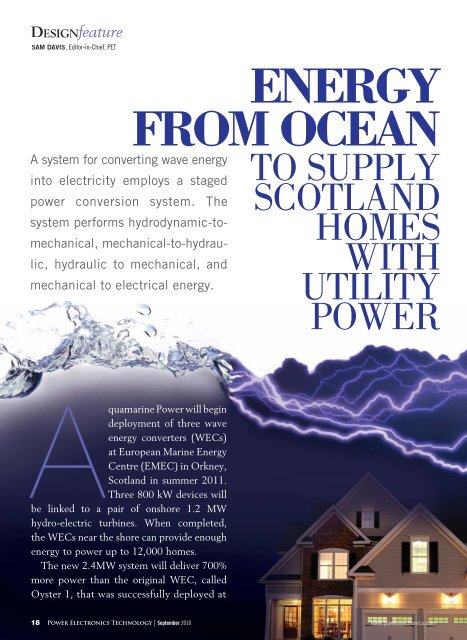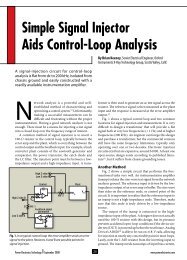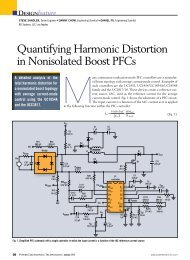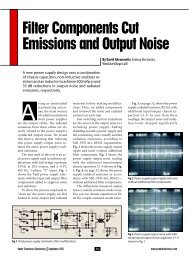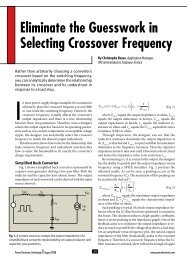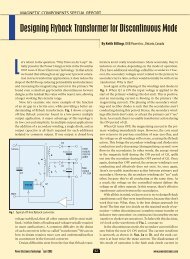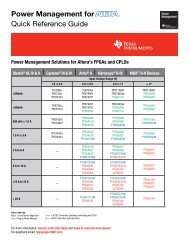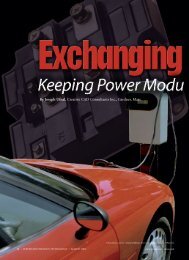here - Power Electronics
here - Power Electronics
here - Power Electronics
Create successful ePaper yourself
Turn your PDF publications into a flip-book with our unique Google optimized e-Paper software.
DESIGNfeature<br />
SAM DAVIS, Editor-in-Chief, PET<br />
ENERGY<br />
FROM OCEAN<br />
A system for converting wave energy<br />
into electricity employs a staged<br />
power conversion system. The<br />
system performs hydrodynamic-tomechanical,mechanical-to-hydraulic,<br />
hydraulic to mechanical, and<br />
mechanical to electrical energy.<br />
A<br />
quamarine <strong>Power</strong> will begin<br />
deployment of three wave<br />
energy converters (WECs)<br />
at European Marine Energy<br />
Centre (EMEC) in Orkney,<br />
Scotland in summer 2011.<br />
Three 800 kW devices will<br />
be linked to a pair of onshore 1.2 MW<br />
hydro-electric turbines. When completed,<br />
the WECs near the shore can provide enough<br />
energy to power up to 12,000 homes.<br />
The new 2.4MW system will deliver 700%<br />
more power than the original WEC, called<br />
Oyster 1, that was successfully deployed at<br />
TO SUPPLY<br />
SCOTLAND<br />
HOMES<br />
WITH<br />
UTILITY<br />
POWER<br />
18 <strong>Power</strong> <strong>Electronics</strong> Technology | September 2010 www.powerelectronics.com
EMEC in Orkney 2009 (Fig.<br />
1). The new version, Oyster 2,<br />
incorporates design improvements,<br />
enabling it to produce<br />
more energy while being easier to<br />
install and maintain. Fig. 2 shows<br />
Oyster 1 in operation.<br />
The basic Oyster WEC consists<br />
of an oscillator flap mounted<br />
on a sub-frame support structure<br />
(Fig. 3). The oscillating action of<br />
waves on the flap drives hydraulic<br />
pistons to pressurize fresh<br />
water, which is then pumped to<br />
shore through the high pressure<br />
pipelines. At shore, a hydroelectric<br />
plant converts the hydraulic<br />
pressure into electrical power via<br />
a Pelton wheel turbine, which<br />
turns an electrical generator tied to the local utility<br />
grid.<br />
Design of the Oyster WEC required a balance<br />
between capital cost and wave power conversion<br />
efficiency efficiency. The key wave power conversion parameters<br />
are water depth, flap geometry, buoyancy<br />
and damping. Its design objective was to maximize<br />
captured wave power per ton of device and foundations.<br />
Oy st ster t er 1 e eext<br />
xtra ract cts po powe w r from the waves by har-<br />
ne ness ssing g th the ho hori rizo zo zont nt n al s ssur<br />
urge ge ccom<br />
om ompo po p ne n nt o oof<br />
f th the h e wave<br />
mo moti ti tion on ttha<br />
ha hat pr p od oduc uc u es f ffor<br />
or o ce ces on o its fla f la l p. p Forces a re r<br />
ma maxi xi ximi m zed d by mmak<br />
ak akin in i g th the e fl f ap p ppen<br />
e etrate the ful ul ull l<br />
wa wate te ter r co colu l mn a<br />
a nd d mmin<br />
in inim imiz izin in ing g leak akag ag a e un unde de dern rn rnea ea eath th<br />
or o from m ov over er erto to topp pp ppin in i g th t e de devi vi vice ce ce. . Wi W de ni ng t tthe<br />
t he fla la lap p<br />
in incr cr crea ea ease se ses th the e fo forc rc r es a pp ppro ro roxi xi xima ma mate te tely ly in n pr prop op opor or orti ti tion o<br />
to the squar a e of o t tthe<br />
he ffla<br />
la lap p wi w dt dth. h.<br />
Howe weve ver, r, aas<br />
s th the e wi w dt dth h in incr cr crea ea ease se ses, s, Fig Fig. 2 . O OOyst<br />
yst y er 1 1i 1 i in<br />
o<br />
th the ma maxi xi ximu mu mum m wa w ve force rrea<br />
ea each ches h<br />
a li limi mi m t du due to phase incoher-<br />
en ence across the flap. Water depth<br />
reduces the water’s horizontal<br />
amplitude, so motion increases<br />
but overall power reduces.Besides<br />
optimizing the power take off,<br />
t<strong>here</strong> are other design considerat<br />
ations that affect installation and<br />
op operating costs:<br />
<br />
an and d se s ab abed ed ccon<br />
o ditions<br />
<br />
to the seabe bed<br />
<br />
removal of the WEC EC E<br />
Fig. 1. Wave action on Oyster 1 causes pressurized fresh water to be pumped to shore through high pressure pipelines<br />
w<strong>here</strong> it produces hydroelectric power. The low pressure return-water passes back to the device in a closed loop.<br />
■ WHAT IS A PELTON WHEEL?<br />
THE PELTON WHEEL is among the most efficient types of water turbines.<br />
The wheel (Fig. 5) 5 extracts energy from the impulse ( momentum)<br />
of moving water, as opposed to its weight like the traditional<br />
overshot water wheel whee . With Pelton Pelton’ss paddle geometry geometry, when the rim<br />
runs at one-half the speed of the water jet, the water leaves the wheel<br />
with very little speed, extracting almost all of its energy, allowing a<br />
very efficient turbine.<br />
Invention of the wheel by Lester Pelton apparently originated from<br />
an accidental observation. Pelton was watching a spinning water turbine<br />
when the key holding its wheel onto its shaft slipped, causing it to<br />
become misaligned. Instead of the jet hitting the cups in their middle,<br />
the slippage made it hit near the edge, rather than stopping the water<br />
flow, it was deflected into a half-circle, coming out again with reversed<br />
direction. Surprisingly, the turbine now moved faster.<br />
n operation n off o ff th t e coas oas oa o t oof<br />
f S Scot<br />
cotlan a d.<br />
www.powerelectronics.com September 2010 | <strong>Power</strong> <strong>Electronics</strong> Technology 19
OC OCEA OC OCEANWAVEenergy<br />
EA EANW NW NWAV NW AV AVE V<br />
Fig. 3. Oyster 1 consists of an oscillator flap mounted on a sub-frame structure. The action of waves on the<br />
flap drives hydraulic pistons which pressurize fresh water that is sent to the shore w<strong>here</strong> it is converted to<br />
electricity.<br />
<br />
<br />
<br />
<br />
DC<br />
Bus<br />
Fuses<br />
SPMC<br />
Controlled<br />
Rectifier for<br />
DC Bus<br />
Pre Charge<br />
Fuses<br />
DC<br />
Bus<br />
Fuses<br />
SPMD<br />
Master Main<br />
Drive Module<br />
DC to AC<br />
Converter<br />
Input<br />
Chokes<br />
Input<br />
Fuses<br />
PWM Filter<br />
DC<br />
Bus<br />
Fuses<br />
SPMD<br />
Slave Main<br />
Drive Module<br />
DC to AC<br />
Converter<br />
Input<br />
Chokes<br />
Input<br />
Fuses<br />
To Utility <strong>Power</strong><br />
Rectifier to Inverter<br />
Control Wiring<br />
DC<br />
Bus<br />
Fuses<br />
SPMD<br />
Master Main<br />
Drive Module<br />
DC to AC<br />
Converter<br />
Input<br />
Chokes<br />
<br />
<br />
<br />
<br />
<br />
<br />
<br />
<br />
<br />
<br />
<br />
<br />
<br />
<br />
<br />
<br />
<br />
<br />
<br />
<br />
<br />
<br />
<br />
<br />
<br />
<br />
<br />
<br />
<br />
<br />
<br />
<br />
<br />
<br />
<br />
<br />
<br />
<br />
<br />
<br />
<br />
<br />
<br />
<br />
<br />
<br />
<br />
<br />
<br />
<br />
<br />
<br />
<br />
20 <strong>Power</strong> <strong>Electronics</strong> Technology y | September 2010 www.powerelectronics.com<br />
DC<br />
Bus<br />
Fuses<br />
SPMD<br />
Slave Main<br />
Drive Module<br />
DC to AC<br />
Converter<br />
Water Input<br />
Input<br />
Chokes<br />
Pelton Wheel Turbine<br />
Direct-Coupled to<br />
Flywheel and<br />
Variable Speed<br />
Induction Generator<br />
Fig. 4. The electrical system drive components that produce electricity and synchronizes it with the associated<br />
electric utility grid.
OC OCEA OC OCEANWAVEenergy<br />
EA EANW NW NWAV NW AV AVE V<br />
Water hitting<br />
….aligned<br />
blade<br />
misaligned<br />
blade<br />
dump the flow directly to an underground tank, bypassing<br />
the Pelton wheel.<br />
ELECTRICAL SYSTEM<br />
The electrical system obtains mechanical power on the<br />
common shaft between the Pelton wheel, generator and<br />
the grid connection at EMEC. The electrical energy is<br />
transferred to the grid via an 11kV interface at EMEC.<br />
The key components of the electrical power system are:<br />
<br />
<br />
<br />
<br />
<br />
Oyster 1 power conversion included a variable frequency<br />
inverter coupled to an induction generator. The Fig. 6. An artist’s rendering of the new version of Oyster wave energy converter<br />
(WEC) that will be deployed starting in 2011.<br />
characteristics of the Pelton turbine. Fig. 4 shows the key<br />
drive components. The flywheel is used to store energy, allowing the gen-<br />
■ WAVE ENERGY CONVERSION<br />
WHEN A BODY OSCILLATES in still water, it creates waves at<br />
the frequency of oscillation. The amplitude of this radiated<br />
wave depends on the size of the body and the amplitude<br />
of its motion. You can consider wave energy absorption as<br />
a destructive interference of this radiated wave with an<br />
incident wave when the correct phase relationship is present.<br />
Wave energy is proportional to the square of the wave<br />
amplitude. Similarly, the reduction in the incident wave<br />
amplitude is related to the energy absorbed by the device.<br />
A simple method of absorbing wave surge energy is to use<br />
a hinge or bearing to allow the body to oscillate in pitch, which<br />
then turns the surge force into a moment, or wave torque.<br />
Moreover, a purely surging device has no in<strong>here</strong>nt spring<br />
force to aid in tuning and to resist nonlinear drift forces.<br />
However pitching devices do, whether it is excess buoyancy<br />
for a bottom hinged device, such as Oyster.<br />
The dynamics of bottom hinged pitching flap type WECs<br />
tend to be inertia dominated and t<strong>here</strong>fore the natural pitchp ing period is generally well above that of the most common<br />
wave energy periods, which is about 5 to 15 seconds.<br />
Fig. 5. The Pelton wheel<br />
(photo) provides an effi-<br />
cient means for converting<br />
the incoming pressurized<br />
fresh water into a rotat-<br />
ing turbine that drives the<br />
generator.<br />
<br />
generator to have a rating of about half the Pelton wheel<br />
power rating.<br />
<br />
the variable speed requirements of the generator with the<br />
other two providing the grid interface. One advantage of<br />
this modular arrangement is that it provides fault tolerance.<br />
If one drive unit should fail, the others can continue<br />
to operate at a reduced power until repaired.<br />
With Oyster 2 (Fig. 6 <br />
<br />
<br />
dynamic performance of clusters of flaps in different geometric<br />
patterns, and modeling the array of devices with<br />
<br />
and spacing of onshore hydroelectric plants. It was always<br />
<br />
and operate, as it does not have the benefit of smoothing<br />
<br />
economies of scale of the onshore hydroelectric plant.<br />
The future wave energy development program also<br />
includes wave-powered desalination by feeding the high<br />
pressure water directly into reverse osmosis tubes.<br />
22 <strong>Power</strong> <strong>Electronics</strong> Technology y | September 2010 www.powerelectronics.com


